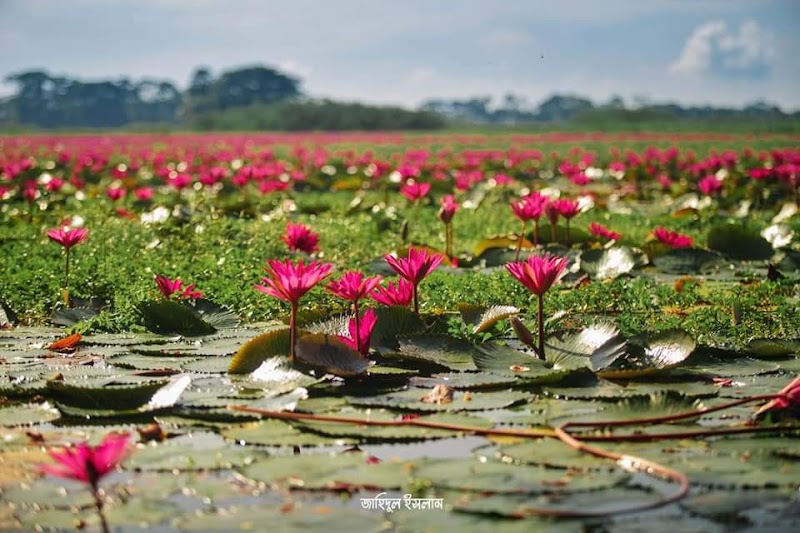
Exploring the Vibrant Cultural Fairs and Markets of Savar, Dhaka Division
Savar’s local fairs and markets provide an authentic glimpse into the heart of Bangladesh’s culture and craft. From handwoven fabrics to rustic spices, these vibrant gatherings invite visitors to engage deeply with traditional artisans and fresh flavors, offering both immersion and practical insights for planning your visit.
Arrive Early to Beat the Heat and Crowds
Start your market trek in the morning to enjoy cooler temperatures, fresher produce, and less crowded stalls, making navigation and conversation easier.
Wear Comfortable, Closed-Toe Shoes
Uneven ground and occasional mud patches require sturdy footwear to keep feet protected during long strolls between market sections.
Carry Cash in Small Bills
Most vendors prefer cash payments; carrying small denominations helps with smooth transactions and fair bargaining.
Bring a Reusable Bag
Markets don’t usually provide packaging, so a durable reusable bag helps carry purchases comfortably and reduces plastic waste.
Exploring the Vibrant Cultural Fairs and Markets of Savar, Dhaka Division
Savar, just outside the bustling heart of Dhaka, pulses with energy and tradition through its local cultural fairs and markets. These events are less about crowds and more about connection—between artisans, farmers, and visitors eager to experience raw, communal life. The fairs offer everything from handwoven textiles to aromatic spices, fresh produce, and traditional crafts, set amid the lively chatter of bargaining and storytelling.
Timing your visit is essential. Many fairs align with seasonal festivals or religious holidays, transforming open fields and community centers into hubs alive with color, sound, and scent. Navigate the markets with purpose: begin early to witness the freshest offerings and engage vendors while the scene is calm. Paths wind through rows of stalls, sometimes across uneven ground, demanding sturdy footwear and watchful steps.
Visual and sensory richness surrounds you—woven fabrics flutter in the breeze like flags bearing history, the smell of fried snacks invites pause, and the rhythmic tap of traditional music challenges you to move with the crowd. The air itself feels charged, daring you to uncover stories etched in patterns on pottery or whispered over cups of sweet chai.
But these fairs also teach practicality. Vendors share knowledge of products and preparation methods. Insight into local ingredients and textiles encourages meaningful purchases, ones that travel beyond souvenirs to become part of your story. A savvy visitor prepares with reusable bags, a clear plan for payment (cash is king), and a willingness to engage honestly and respectfully.
Exploring these cultural hotspots offers not just shopping or sightseeing but a step into a living, breathing landscape fiercely proud of its identity. The experience demands attentiveness and kindness—a balance between observer and participant. Whether you’re seeking flavors, crafts, or simply human energy, Savar’s cultural fairs deliver a grounded, vivid adventure worth planning for.
Nearby Trips
All Adventures
Boat Charters
Water Activities
Adventures near Savar, Dhaka Division
Discover the unique and memorable adventures that make Savar, Dhaka Division special.
Frequently Asked Questions
When are the largest cultural fairs held in Savar?
The biggest fairs typically occur during major festivals like Eid-ul-Fitr and Eid-ul-Adha, as well as the Bengali New Year (Pohela Boishakh). These periods fill the markets with a heightened atmosphere of celebration and more diverse artisans.
Are there any special foods to try at these fairs?
Yes, look for traditional snacks like piyaju (lentil fritters), jilapi (sweet syrupy fried dough), and fresh pitha (rice cakes) specific to the season or festival. Vendors often prepare food on-site, adding to the vibrant sensory experience.
Is it safe and easy to navigate the markets for solo travelers?
Savar’s markets are generally safe and welcoming, but as with any crowded area, staying vigilant is wise. Early hours are quieter for solo visitors, and practicing respectful bargaining enriches local interactions.
Can I find local handicrafts at these markets?
Absolutely. Many stalls feature handmade textiles, pottery, bamboo crafts, and traditional jewelry, often crafted by families or small community groups preserving centuries-old skills.
Are there specific markets or fairs that showcase unique cultural aspects of Savar?
The Savar Haat, a weekly market, offers a consistent view of rural and urban trade, while special seasonal fairs around Durga Puja and other cultural events highlight religious and artistic traditions unique to the region.
How can I respectfully engage with vendors and artisans?
Showing genuine interest by asking questions about products and their making process fosters goodwill. Bargaining is part of the culture but keep it polite and realistic. Small purchases support families directly.
Recommended Gear
Comfortable Walking Shoes
Closed-toe shoes protect your feet against uneven terrain and crowds.
Reusable Shopping Bag
Carrying your purchases with ease while reducing waste.
Water Bottle
Hydrate frequently under the sun’s push during summer months.
Light Scarf or Poncho
Protect against dust and unexpected rain showers.
Local Insights
Hidden Gems
- "The quiet corner stalls often house exquisite hand-painted scrolls and folk-art not found in main aisles."
- "Small pockets of traditional music performances take place on makeshift stages adding layers to your visit."
Wildlife
- "Though urbanized, local birdlife like the Asian koel and mynas share the air, their calls weaving through market sounds."
History
"Savar’s markets have roots as barter hubs on ancient trade routes; their continuation reflects resilience amid urban expansion."
